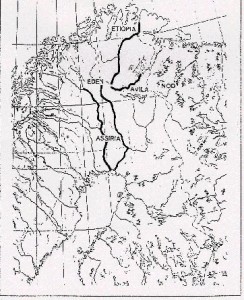Lofoten Islands
Joramo, Morten Alexander
 Morten Alexander Joramo is a Norwegian astrologer, musician and author. In his 2011 book, The Homer Code[1075], he is heavily influenced by Felice Vinci, who situated Homer’s Odyssey in the northern European region. Joramo specifically identifies the island of Trenyken, in Norway’s Outer Lofoten Islands, with Homer‘s legendary Thrinacia. He also refers to the work of Iman Wilkens and Jürgen Spanuth. He also introduces the Bock Saga in support of his contention that “that there must have been an advanced culture in the high north thousands of years ago.”(a)
Morten Alexander Joramo is a Norwegian astrologer, musician and author. In his 2011 book, The Homer Code[1075], he is heavily influenced by Felice Vinci, who situated Homer’s Odyssey in the northern European region. Joramo specifically identifies the island of Trenyken, in Norway’s Outer Lofoten Islands, with Homer‘s legendary Thrinacia. He also refers to the work of Iman Wilkens and Jürgen Spanuth. He also introduces the Bock Saga in support of his contention that “that there must have been an advanced culture in the high north thousands of years ago.”(a)
Although the author touches on the subject of Atlantis in The Homer Code he expands more fully on it the following year in Atlantis Unveiled[1076]. In it he again follows much of Vinci’s work as well as Spanuth’s identification of Helgoland as the location of Atlantis. He also uses Homer as well as copious extracts from Apollonius of Rhodes to justify his identification of Northern Europe as the backdrop to both the Odyssey and Plato’s Atlantis narrative.
Up to this point I found his work interesting, if not convincing. However, when I got to his ancient alien conspiracy theory and the use magic mushrooms, I cried halt.
In 2015, Joramo published The Lost Civilization of the North[1170], which is intended to supplant Atlantis Unveiled.
(a) https://www.goodreads.com/book/show/11337705-the-homer-code
(b) https://www.goodreads.com/book/show/22156233-atlantis-unveiled
Scylla and Charybdis
Scylla and Charybdis were a sea monster and a whirlpool in Greek mythology that according to Homer and other writers were located opposite each other across a narrow strait. This led to the idiomatic phrase “between Scylla and Charybdis” similar to our more modern phrase of being “between the devil and the deep blue sea” describing being caught between two opposing forces.
Many, such as Heinrich Schliemann[1243], assume the original to have been located between Sicily and the Italian mainland at the Strait of Messina.>However, Ernle Bradford, who retraced the voyage of Odysseus, voiced his view that Corfu was the land of the Phaeacians and noted that “the voice of antiquity is almost as unanimous about Scheria being Corfu as it is about the Messina Strait being the home of Scylla and Charybdis.”<
Arthur R. Weir in a 1959 article(d) refers to ancient documents, which state that Scylla and Charybdis lie between the Pillars of Hercules(c).
A minority have opted for the Scylla being Calpe (The Rock of Gibraltar) and Charybdis being Mt. Abyla across the strait in North Africa or in other words the Pillars of Heracles(a). However, Professor Arysio Santos promoting his Atlantis in Indonesia theory suggested that the ‘original’ Pillars of Heracles were in at Sunda Strait and later brought to ancient Greece where it was included by Homer in his Odysseus as Scylla and Charybdis!(b)
Anatoly Zolotukhin has proposed that Scylla & Charybdis had been situated in the Bosporus near the Pillars of Heracles, while he located Atlantis itself in Crimea near Evpatoria(e).
Writers who have located the wanderings of Ulysses in the North Atlantic have gone further afield in their search for Scylla and Charybdis with suggestions such as the west coast of Scotland (Pillot[742] and Nyland[394]), the Orkneys (Sora)[395] southwest Cornwall (Janssen)(f) and near the Scilly Isles (Wilkens)[610].
More recently, Andres Pääbo wrote that ” many of the details in Odysseus’ (or Ulysses’) travels can be easily associated with locations along the Norwegian coast and islands north of the British Isles. The starkest northern location found in the Odyssey is the large whirlpool called Charybdis, identifiable with the famous Maelstrom off the Lofoten Islands (g)”
Perhaps the most distant Atlantic location was proposed by Henriette Mertz in The Wine Dark Sea [0397] to have been in Canada’s Bay of Fundy, reputed to experience the world’s greatest tidal range averaging 52 feet.
In January 2022, Kalju Pattustaja published a paper(h) in which he placed Scylla off the Kola Peninsula in northwest Russia. Coincidentally, Russia claims to have ancient pyramids on the Kola Peninsula(i).
(a) See: https://web.archive.org/web/20120224202757/https://www.cadiznews.co.uk/info2.cfm?info_id=29858
(c) https://drive.google.com/file/d/10JTH401O_ew1fs8uhXR9C5IjNDvqnmft/view
(d) Atlantis – A New Theory, Science Fantasy #35, June 1959 pp 89-96
(e) https://homerandatlantis.com/wp-content/uploads/2016/08/Scylla-CharybdisJAH-1.pdf
(f) http://www.homerusodyssee.nl/id24.htm
(h) https://new-etymology.livejournal.com/466128.html
(i) https://culturacolectiva.com/travel/russia-pyramids-kola-peninsula-discovery-older-egypt/
Vinci, Felice
Felice Vinci (1946- ) is an Italian nuclear engineer with a background in Latin and Greek studies  and is a member of MENSA, Italy. He believes that Greek mythology had its origins in Northern Europe.
and is a member of MENSA, Italy. He believes that Greek mythology had its origins in Northern Europe.
His first book on the subject in 1993, Homericus Nuncius[1358], was subsequently expanded into Omero nel Baltico[0018] and published in 1995. It has now been translated into most of the languages of the Baltic as well as an English version with the title of The Baltic Origins of Homer’s Epic Tales[0019]. The foreword was written by Joscelyn Godwin.
Vinci explained that “I have been interested in the Greek poet Homer and Greek mythology since I was seven years old. My elementary school teacher gave me a book about the Trojan War, so the leading characters of Homer’s poem, ‘Iliad,’ were as important for me as Mickey Mouse and Donald Duck.
“In 1992, I found the Greek historian Plutarch‘s key-indication which positioned the island Ogygie in the North Atlantic ocean. I decided to dedicate myself to this research. The ancient Greek that I had studied in secondary school helped me very much. Subsequently, I was helped and encouraged by Professor Rosa Calzecchi Onesti, a famous scholar who has translated both of Homer’s poems, ‘Iliad’ and ‘Odyssey,’ into Italian. Her translations are considered a point of reference for scholars in Italy.”(s)
Readers might find two short reviews of Vinci’s book on an Icelandic website (in English) of interest(t)(u).
However, the idea of a northern source for Homeric material is not new. In the seventeenth century, Olof Rudbeck insisted that the Hyperboreans were early Swedes and by extension, were also Atlanteans. In 1918, an English translation of a paper by Carus Sterne (Dr Ernst Ludwig Krause)(1839-1903) was published with the title of The Northern Origin of the Story of Troy(m).
Vinci offers a compelling argument for re-reading Homer’s Iliad and Odyssey with the geography of the Baltic rather than the Mediterranean as a guide. A synopsis of his research is available on the Internet(a).
His book has had positive reviews from a variety of commentators(j). Understandably, Vinci’s theory is not without its critics whose views can also be found on the internet(d)(b)and in particular I wish to draw attention to one extensive review by Andreas Pääbo which is quite critical(k).>His objections are based on a firm contention that the Odyssey and the Iliad came from two different authors(v).<
Stuart L. Harris has written a variety of articles for the Migration and Diffusion website(c) including a number specifying a Finnish location for Troy following a meeting with Vinci in Rome. M.A. Joramo was also influenced by Vinci’s work and has placed the backdrop to Homer’s epic works in northern European regions, specifically identifying the island of Trenyken, in Norway’s Outer Lofoten Islands, with Homer’s legendary Thrinacia. An Italian article also links the Lofotens with some of Homer’s geographical references(r).
Jürgen Spanuth based his Atlantis theory[015] on an unambiguous identification of the Atlanteans with the Hyperboreans of the Baltic region. More specifically, he was convinced [p88] that the Cimbrian peninsula or Jutland, comprised today of continental Denmark and part of northern Germany had been the land of the Hyperboreans.
As a corollary to his theory, Vinci feels that the Atlantis story should also be reconsidered with a northern European origin at its core. He suggests that an island existed in the North Sea between Britain and Denmark during the megalithic period that may have been Plato’s island. He also makes an interesting observation regarding the size of Atlantis when he points out that ‘for ancient seafaring peoples, the ‘size’ of an island was the length of its coastal perimeter, which is roughly assessable by circumnavigating it’. Consequently, Vinci contends that when Plato wrote of Atlantis being ‘greater’ than Libya and Asia together he was comparing the perimeter of Atlantis with the ‘coastal length’ of Libya and Asia.
Malena Lagerhorn, a Swedish novelist, has written two books, in English, entitled Ilion [1546] and Heracles [1547], which incorporate much of Vinci’s theories into her plots(l). She has also written a blog about the mystery of Achilles’ blond hair(n).
Alberto Majrani is another Italian author, who, influenced by Vinci, is happy to relocate the origins of many Greek myths to the Nordic regions [1875]. Although his focus is on the Homeric epics, he has also touched on Plato’s Atlantis story, proposing, for example, that the Pillars of Heracles were a reference to the thousands of basaltic columns, known as the ‘Giant’s Causeway’ to be found on the north coast of Ireland with a counterpart across the sea in Scotland’s Isle of Staffa.(o)
Not content with moving the geography of Homer and Plato to the Baltic, Vinci has gone further and transferred[1178] the biblical Garden of Eden to the same region(e). Then in a more recent blog(q) he repeats his views on the location of Eden in Lapland and reiterates his core thesis that “the real scenario of the events of the Iliad and the Odyssey was the Baltic-Scandinavian world, the primitive seat of the blond Achean navigators: they subsequently descended into the Mediterranean, where, around the beginning of the sixteenth century BC., they founded the Mycenaean civilization.”
A 116 bullet-pointed support for Vinci from a 2007 seminar, “Toija and the roots of European civilization” has been published online(h). In 2012 John Esse Larsen published a book[1048] expressing similar views.
 An extensive 2014 audio recording of an interview with Vinci on Red Ice Radio is available online(f). It is important to note that Vinci is not the first to situate Homer’s epics in the Atlantic, northern Europe and even further afield. Henriette Mertz has Odysseus wandering across the Atlantic, while Iman Wilkens also gives Odysseus a trans-Atlantic voyage and just as controversially locates Homer’s Troy in England[610]. Edo Nyland has linked the story of Odysseus with Bronze Age Scotland[394].
An extensive 2014 audio recording of an interview with Vinci on Red Ice Radio is available online(f). It is important to note that Vinci is not the first to situate Homer’s epics in the Atlantic, northern Europe and even further afield. Henriette Mertz has Odysseus wandering across the Atlantic, while Iman Wilkens also gives Odysseus a trans-Atlantic voyage and just as controversially locates Homer’s Troy in England[610]. Edo Nyland has linked the story of Odysseus with Bronze Age Scotland[394].
Christine Pellech has daringly proposed in a 2011 book[0640], that the core narrative in Homer’s Odyssey is a description of the circumnavigation of the globe in a westerly direction(i). These are just a few of the theories promoting a non-Mediterranean backdrop to the Illiad and Odyssey. They cannot all be correct and probably all are wrong. Many have been seduced by their novelty rather than their provability. For my part I will, for now, stick with the more mundane and majority view that Homer wrote of events that took place mainly in the central and eastern Mediterranean. Armin Wolf offers a valuable overview of this notion(g).
It is worth noting that Bernard Jones has recently moved [1638] Troy to Britain, probably in the vicinity of Cambridge! Like many others, he argues that Homer’s Iliad and Odyssey were not set in the Mediterranean as so many of the details that he provides are incompatible with the characteristics of that sea. However, Jones has gone further and claimed that there are details in Virgil’s Aeneid, which are equally inconsistent with the Mediterranean[p.6-10], requiring a new location!
Felice Vinci is also a co-author (with Syusy Blady, and Karl Kello) of Il meteorite iperboreo [1906] in which the Kaali meteor is discussed along with its possible association with the ancient Greek story of Phaeton.
More recently, Vinci wrote a lengthy Preface(p) to Marco Goti‘s book, Atlantide: mistero svelato[1430], which places Atlantis in Greenland!
(a) The Location of Troy | Felice Vinci (archive.org)
(b) https://mythopedia.info/Vinci-review.pdf
(c) http://www.migration-diffusion.info/article.php?authorid=113
(d) https://homergeography.blogspot.ie/
(e) http://www.cartesio-episteme.net/episteme/epi6/ep6-vinci2.htm
(f) https://www.youtube.com/watch?v=P6QPtcZWBPs
(g) Wayback Machine (archive.org) See: Note 5
(h) https://www.slideshare.net/akela64/1-aa-toija-2007-English
(i) https://www.migration-diffusion.info/books.php
(j) https://www.migration-diffusion.info/article.php?id=44
(k) https://www.paabo.ca/reviews/BalticHomericVinci.html
(m) The Open Court magazine. Vol.XXXII (No.8) August 1918. No. 747
(n) https://ilionboken.wordpress.com/insight-articles/the-mystery-of-achilless-blond-hair/
(o) https://ilionboken.wordpress.com/insight-articles/guest-article-where-were-the-pillars-of-hercules/
(p) Atlantis: Mystery Unveiled – The Tapestry of Time (larazzodeltempo.it)
(s) https://www.encyclopedia.com/arts/educational-magazines/vinci-felice-1946
(v) (26) The Odyssey’s Northern Origins and a Different Author Than Homer | Andres Pääbo – Academia.edu *
